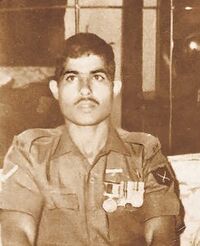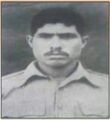Jai Singh Rathee

Jai Singh Rathee (Hony. Capt.) of Asanda village in Jhajjar in Haryana is the recipient of Vir Chakra for his exemplary courage during war with Pakistan, 1971. He was born on April 2, 1946 and retired from service on 30 November 1993.
Hony Capt Rathee — the destroyer of Pak tanks
(Article in The Tribune, Chandigarh dated 16 Dec. 2020)
- By Col. Dilbag Dabas (Retd)
“Rathee Sahab, you knocked out so many enemy tanks during the 1971 war with Pakistan. Were you not injured during the encounters?” The septuagenarian veteran, with glow on his face, says, “Sahab, mein war main ghayal hone nahin gaya tha. Dushman ko ghayal karne gaya tha, maarne gaya tha” (I went into the war not to get wounded but to wound or kill the enemy). “But you got the gallantry award”. And the veteran aptly sums up with a question: “Award jeetne ke liye ghayal hona ya marna zaroori hai ke” (is it necessary to get wounded or get killed to win a gallantry award)? The veteran is Honorary Captain Jai Singh Rathee, who, as a young Sowar in Deccan Horse, was awarded the Vir Chakra (Vr C) during the 1971 war with Pakistan.
Jai Singh is a third generation cavalryman; his grandfather, during World War I, served in 14th Murray's Jat Lancers (the present day Deccan Horse) and his four uncles fought the Japanese in the Burma campaign during World War II and were also part of combat arms during the 1962 and 1965 wars. Jai Singh, son of Sri Kali Ram, grew up listening to the stories of valour of Indian Army soldiers from his ‘fauji’ uncles and knew he was destined to be one. He was born at Asanda village in Rohtak district on April 2, 1946. Asanda is now in Jhajjar district. After matriculation from High School at Bhaprodha, Jai Singh’s dream materialised when on October 20, 1965, he was enrolled in 9 Horse (Deccan Horse), his grandfather’s regiment. Sowar Jai Singh Rathee was awarded the Vir Chakra for his dauntless courage and conspicuous act of bravery in the line of fire during the 1971 war with Pakistan. The battle account of the action in which he singlehandedly destroyed nine enemy tanks and four recoilless guns is recorded in the War Diary of Deccan Horse.
Sowar Jai Singh Rathi retired from active service on November 30, 1993, as Honorary Captain. His son has carried forward his legacy. Risaldar Virender Singh, son of Captain Jai Singh Rathee, is a serving Junior Commissioned Officer in Deccan Horse (his father’s regiment) and the grandson is gearing up to follow in the footsteps of this proud Jat clan and Rathee family.
Voluntarily, Captain Rathee works in close coordination with the Zila Sainik Board and the district administration to ensure that ex-servicemen, especially war widows, are treated with dignity. He periodically organises pension adalats to address pension-related matters of the military retirees and their widows. From time to time, he organises blood donation camps and also motivates the youth to join the defence services.
For almost a decade, Honorary Captain Jai Singh Rathee has also been in the forefront of various ex-servicemen movements. Asked if he is satisfied with what the government is doing for the ex-servicemen, the Honorary Captain speaks his heart with anguish: “Satisfy kahan, government to ex-servicemen ki poorn roop se andekhi kar rahi hai. Paanch saal pahle one rank one pension (OROP) ka vaida karke hamari vote le li lekin aaj tak vaida poora nahin kiya. Pichhle sadhe teen saal se OROP ke liye Jantar Mantar par ex-servicemen lagatar sangharsh kar rahe hain”.
Captain Rathee is right. Ex-servicemen are indeed at Jantar Mantar seeking the implementation of the promised OROP.
The summary of the battle in War Diary of Deccan Horse reads...
During the 1971 war with Pakistan in western theatre, Sowar Jai Singh Rathee was a gunner in Regimental Headquarters tank attached with the Bravo (Jat) Squadron deployed in the Chhamb sector. On December 4, 1971, during an enemy armour assault, despite being heavily shelled by the enemy artillery and mortars, Sowar Jai Singh Rathee continued to fire his gun with utmost accuracy and destroyed seven T 59 tanks and one recoilless gun of the enemy, making the battleground a graveyard of enemy tanks. Not risking any more losses, the enemy retreated.
After regrouping, and in vengeance, after two days, the enemy launched another tank assault with an entire troop of three tanks directed at the tank of Sowar Jai Singh, as if they had marked his deadly tank during the first encounter. And then began the dog fight with one tank pitted against three superior in number and technology. Unmindful of his safety, Sowar Jai Singh Rathee got his tank manoeuvred into an advantageous position and destroyed two more enemy tanks and three recoilless guns. By inflicting so much damage to the enemy's armour, Sowar Jai Singh Rathee was instrumental in thwarting the enemy tank thrust in the Chhamb sector. Throughout the battles, Sowar Jai Singh Rathee displayed gallantry and professional skill of a high order.
- (The writer is a veteran Gunner, 6 Field Regiment)
सवार जय सिंह राठी
सवार जय सिंह राठी वीर चक्र
यूनिट - 9 हॉर्स (डेक्कन हॉर्स)
ऑपरेशन कैक्टस लिली
भारत-पाक युद्ध 1971
सवार जय सिंह राठी का जन्म ब्रिटिश भारत में 2 अप्रैल 1946 को तत्कालीन पंजाब (वर्तमान हरियाणा) के रोहतक जिले (वर्तमान झज्जर जिला) के असंदा गांव में श्री काली राम राठी के घर में हुआ था। 20 अक्टूबर 1965 को वह भारतीय सेना के आर्मर्ड कॉर्प्स में रंगरूट के रूप में भर्ती हुए थे। प्रशिक्षण के पश्चात उन्हें 9 हॉर्स (डेक्कन हॉर्स) में सवार के पद पर नियुक्त किया गया था।
सवार जय सिंह तीसरी पीढ़ी के घुड़सवार हैं; उनके दादा, प्रथम विश्व युद्ध में, 14th Murray's जाट लांसर्स (वर्तमान डेक्कन हॉर्स) में सेवारत थे और उनके चार काकाओं ने द्वितीय विश्व युद्ध में बर्मा अभियान में जापानियों से युद्ध किया था व 1962 और 1965 के युद्धों में भी भाग लिया था।
1971 के भारत-पाकिस्तान युद्ध में सवार जय सिंह पश्चिमी मोर्चे पर छंब सेक्टर में तैनात ब्रावो (जाट) स्क्वॉड्रन से जुड़े रेजिमेंटल मुख्यालय टैंक में गनर थे। 4 दिसंबर 1971 को, शत्रु के कवचित आक्रमण में, शत्रु के तोपखाने और मोर्टार द्वारा भारी गोला वृष्टि होते हुए भी, सवार जय सिंह अपने टैंक की तोप से अत्यंत सटीकता से गोला वृष्टि करते रहे और शत्रु के सात टी-59 टैंकों और एक रिकॉइललेस गन को नष्ट कर दिया। यह युद्ध का मैदान शत्रु के टैंकों का श्मशान बन गया। किसी और क्षति का संकट नहीं उठाते हुए, एकबार शत्रु पीछे हट गया।
दो दिनों के पश्चात, शत्रु ने पुनः संगठित होकर और प्रतिशोध में, सवार जय सिंह के टैंक पर तीन टैंकों की टुकड़ी के साथ एक और आक्रमण किया, शत्रु ने जैसे प्रथम मुठभेड़ में ही उनके घातक टैंक को चिह्नित कर लिया था। पुनः तीन टैंकों और एक टैंक के मध्य अनुपातहीन भयानक युद्ध हुआ, जिसमें संख्या और तकनीक में तीनों शत्रु टैंक उनसे श्रेष्ठ थे।
अपनी सुरक्षा पर ध्यान नहीं देते हुए, सवार जय सिंह ने अपने टैंक को चतुराई से एक लाभप्रद स्थिति में तैनात किया और शत्रु के दो टैंकों और तीन रिकॉइललेस तोपों को भी नष्ट कर दिया। शत्रु के कवच (ARMOUR) को इतनी क्षति पहुंचाकर सवार जय सिंह ने छंब सेक्टर में शत्रु के टैंकों को विफल करने में महत्वपूर्ण भूमिका निर्वहन की।
इस संपूर्ण युद्ध में, सवार जय सिंह ने उच्च कोटि की वीरता और व्यावसायिक कौशल का प्रदर्शन किया। उन्हें वीर चक्र से सम्मानित किया गया। वह रिसालदार मेजर के पद तक पहुंचे और 30 नवंबर 1993 को मानद कैप्टन के रूप में वह सेवानिवृत्त हुए थे।
सेवानिवृत्ति के पश्चात कैप्टन राठी स्वेच्छा से जिला सैनिक बोर्ड और जिला प्रशासन के साथ मिलकर कार्य करते हैं। पूर्व सैनिकों, विशेष रूप से सैनिक वीरांगनाओं के साथ सम्मान का व्यवहार किया जाए। सेवानिवृत्त सैनिकों और वीरांगनाओं के पेंशन संबंधी प्रकरणों को निष्पादित करने के लिए वह समय-समय पर पेंशन अदालतों का आयोजन करते हैं। रक्तदान शिविर आयोजित करते हैं और युवाओं को रक्षा सेवाओं में सम्मिलित होने के लिए भी प्रेरित करते हैं।
स्रोत: रमेश शर्मा
Gallery
-
Jai Singh Rathee
-
Jai Singh Rathee
-
Jai Singh Rathee
-
राष्ट्रपति भवन में अलंकरण समारोह के पश्चात तत्कालीन राष्ट्रपति वीवी गिरी के साथ सोवर जय सिंह राठी।
-
आ. कैप्टन जय सिंह राठी पर दैनिक जागरण (दिनांक 16 दिसंबर 2020) में लेख
External Links
References
Back to The Brave People





